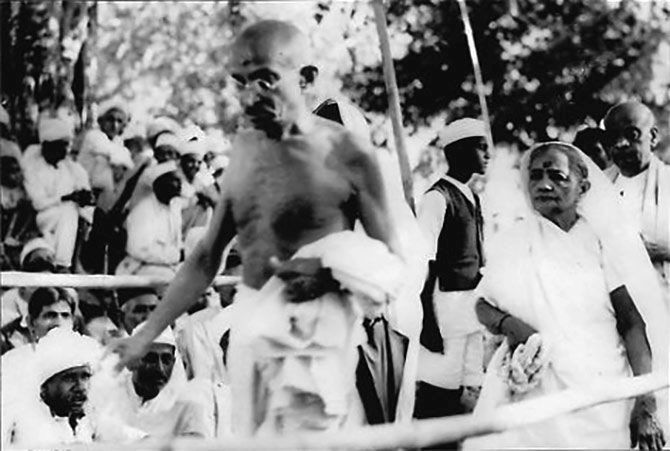
 The spectre of global conflict – after Sri Lanka, Bangladesh, and now Nepal, is the latest example – with its devastating consequences and seemingly endless cycles of violence, casts a long shadow over humanity. In such times, the idea of nonviolence emerges not merely as a utopian ideal, but as a profoundly alluring and increasingly urgent necessity.
The spectre of global conflict – after Sri Lanka, Bangladesh, and now Nepal, is the latest example – with its devastating consequences and seemingly endless cycles of violence, casts a long shadow over humanity. In such times, the idea of nonviolence emerges not merely as a utopian ideal, but as a profoundly alluring and increasingly urgent necessity.
The idea offers a path away from the destructive logic of war, a beacon of hope in a world often consumed by hatred and retribution. This alluring idea of nonviolence – in an age of drones, grey-zone warfare, and rolling news of atrocities – often stands in stark contrast with the Gandhian philosophy. Yet, precisely in times of global conflict, Gandhian philosophy – rooted in truth-force (Satyagraha), disciplined self-restraint, and the stubborn dignity of conscience – regains its sharpest relevance.
Nonviolence is not passive. It is an active, morally demanding strategy for confronting injustice without reproducing it. Mahatma Gandhi called it “the greatest force at the disposal of mankind”, a claim that invites serious consideration rather than pious quotation.
Satyagraha provides a powerful framework for understanding and implementing nonviolent action. Gandhi’s teachings, far from being relics of a bygone era, remain strikingly relevant in navigating the complex and interconnected conflicts of the 21st century, offering practical and ethical solutions with historical precedents across the globe, including his own transformative leadership in India.
The allure of nonviolence stems from its fundamental recognition of the inherent worth and dignity of every human being. Unlike violent conflict, which dehumanises the “enemy” and thrives on destruction, nonviolence seeks to appeal to the conscience and reason of the opponent, fostering empathy and ultimately creating the possibility for reconciliation and lasting peace. As the renowned American historian Howard Zinn eloquently stated, “You can’t be neutral on a moving train.”
In the context of conflict, choosing nonviolence is an active and powerful stance against the perpetuation of suffering. It acknowledges the reality of injustice and oppression but rejects the premise that violence is the only or the most effective means of addressing it.
To German historian Hannah Arendt, “Power and violence are opposites; where the one rules absolutely, the other is absent.” Violence, she observed, appears when power is in jeopardy but ultimately erodes it. In this view, nonviolence does not reject power; it seeks to build durable power – legitimacy, organisation, and consent – without the shortcut of coercion. Gene Sharp, the great analyst of civil resistance, stressed this operationally and said that nonviolent action is a technique for “controlling, combating, and destroying the opponent’s power by nonviolent means.”
Evidence bears this out. American political scientists Prof. Erica Chenoweth and Maria J. Stephan examined hundreds of movements from 1900 to 2006 and found that nonviolent campaigns were more than twice as effective as violent ones at achieving major political change. Their work also popularised the idea that participation by roughly 3.5% of a population can tip the balance.
The reasons are practical. Nonviolent methods lower barriers to entry, draw in diverse constituencies, and are more likely to crack the loyalty of security forces. None of these guarantees victory. Repression can be ruthless, but it shows why Gandhian tools retain strategic bite.
Gandhi’s philosophy of Satyagraha provides a comprehensive approach to nonviolent action, and it is rooted in the principles of truth, non-injury (ahimsa), and self-suffering. For Gandhi, Satyagraha was not passive resistance but an active and courageous engagement with injustice. It involved a relentless pursuit of truth and a willingness to endure hardship without resorting to violence. His leadership in India’s struggle for independence offers a powerful example of the transformative potential of nonviolent resistance.
Decades after independence, Gandhian currents still course through Indian public life. Environmental movements such as Chipko and the Narmada Bachao Andolan used nonviolent pickets, fasts, and satyagraha-style persuasion to force national debates about development, livelihood, and rights.
Throughout history, and in contemporary conflicts, we find examples of nonviolent movements and individuals who have drawn inspiration from his teachings. The American Civil Rights Movement, led by Martin Luther King Jr., is a prime example. King himself acknowledged the profound influence of Gandhi, stating, “Christ furnished the spirit and motivation, and Gandhi furnished the method.”
ALSO READ:
- When the Bard met the Mahatma
- A spiritual journey to freedom
- The enduring legacies of Gandhi and Mandela
Also, in the Philippines in 1986, ‘People Power’ reclaimed a stolen election; in Poland, Solidarity paired strikes with negotiation; in Czechoslovakia, the Velvet Revolution – and later Serbia and Georgia – showed how trained, decentralised activists could outmanoeuvre hard-nosed incumbents without picking up arms. Furthermore, South Africa’s anti-apartheid struggle included nonviolent mass action and, at times, armed resistance. Yet the negotiated transition that followed bore the imprint of nonviolence’s long work such as civic organising, international sanctions, and the moral leadership of figures like Archbishop Desmond Tutu, who insisted, “Without forgiveness, there is no future.”
Gandhian philosophy also travels beyond the street into statecraft and daily life. Its core wager is that means and ends are inseparable. The methods we use will prefigure the society we get. In an era of hybrid warfare and viral misinformation, that intuition warns against embracing ‘our side’s’ cruelty as a necessary evil. It also reframes security.
True security is not merely the defeat of an enemy but the restoration of relationships without which peace cannot last. The Dalai Lama, while talking about sustainable methods for addressing conflicts, also believes that violence only leaves corrosive tails of grievance.
Training is crucial because nonviolence asks ordinary people to do extraordinary things: to withstand beatings without retaliating, keep marches disciplined, and maintain focus when provocateurs try to spark chaos. Gandhi himself acknowledged the difficulties of adhering to nonviolence in all circumstances. He recognised the potential for violence to arise even within nonviolent movements and emphasised the importance of rigorous self-discipline and a commitment to truth and non-injury.
And as the world remembers the violent tragedy of September 11, 2001 (the falling of the World Trade Centre), a profoundly different and more powerful 9/11 occurred in 1906. On that day, Mahatma Gandhi initiated his first Satyagraha in Johannesburg – a solemn pledge of nonviolent resistance against an unjust law. This was the birth of a constructive philosophy, proving that courage lies not in destruction but in principled defiance.
Remembering Gandhi’s 9/11 offers humanity a blueprint for change, celebrating a force that builds, not destroys. It’s a day to be celebrated annually, a testament to the enduring power of peace over the devastating futility of violence. Against the fatalism bred by ceaseless conflict, Gandhian philosophy offers a stubbornly realistic hope – that human beings can resist injustice without becoming its mirror, and thereby build a peace that does not rest on fear. That is hard and, yet, today, necessary everywhere.





